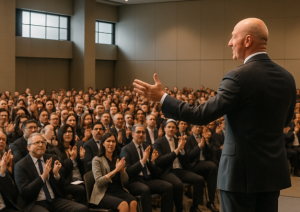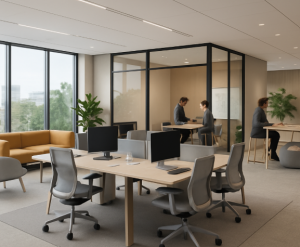8 Considerations for GCCs Returning to the Office – ANSR Blog
Published on
As more and more vaccinations are administered and the pandemic showing signs of decline, organizations are contemplating if, when, and how they can safely facilitate the return of their employees to the workplace. Against the backdrop of restrictions being eased and offices re-open, ANSR’s Leadership Forum invited leaders from the GCC space to discuss their challenges and lessons from returning to work. Nearly 40 guests joined us from leading Global Capability Centers, like Walmart Tech India, Target, Falabella, Lowe’s, Amadeus Labs, Allstate, ANZ, and Morgan Stanley to name a few., consulting organizations like KPMG and NASSCOM, and the leadership team at ANSR. In this article, we summarise the key takeaways from this conversation.
#1 Change your office space to better suit your future
Until last year, office space was about one seat per employee and some conference rooms for discussions. It was the physical space in which work got done. In the future, an employee won’t need to be at the office to do their job. What they need offices for is collaboration, building a sense of community, and finding their belonging. Workspaces of the future will need to reflect that based on effective GCC models.
“Not everyone can work from home. At Walmart, we have store staff, transportation staff etc., who have to come to the workplace. But within tech, we have more flexibility. While imagining the future workplace, we need to account for such heterogeneity.” — Hari Vasudev, Country Head & SVP – Technology at Walmart Global Tech India.
#2 Look for tech that facilitates more than just tasks
In 2020, much of the tech investments that organisations made were in making work happen. This included tools for communication, video conferencing, tracking etc. In the future, technology must enable the aspects that are often missed in remote work — community, engagement, learning, behaviour modelling etc. For instance, Shalini Pillay, India Leader, Global Capability Centres at KPMG, observed that there are advanced artificial intelligence tools that leverage behavioural patterns to send timely personalised triggers that can improve productivity. “This isn’t about screen tracking or monitoring. This is about using AI to augment employee experience,” she added.
#3 Bring back social interactions to work at GCCs
For many employees — for instance, young people living away from home or new to a city — work is also where their social life is. When people stop coming to the office, many lose out on this aspect of their life, affecting their overall mental health and emotional wellbeing. Organisational leaders must inspire employees to come to the office as often as possible to avail these advantages.
#4 Re-evaluate employee remuneration
Labour regulations are state subject. Even though you are headquartered in one state, if your employees work from another state, the applicable laws might change. When employees work from non-metros, their compensation package might also change. As Global Capability Centers, also known as Global Inhouse Centers, move towards a hybrid model, it is essential to redesign remuneration and benefits packages to meet the needs of the new situation.
#5 Work from the same city vs work from anywhere
Hybrid models — where employees come to the office 1-2 days a week — require them to live in the same city. For many who have moved back to their hometowns and found comfort and convenience there, returning to a crowded city can be disheartening. One has to design policies that include such employees as well. “In our organisation, we noticed that the spouse’s work status was important to have people return to the office. In several cases, we interviewed and made offers to the spouse as well to make sure the family feels comfortable moving back to Bangalore,” said Dr. Shivananda Koteshwar, Group Director, DG Digital Implementation Site-Leader and R&D Head at Synopsys.
#6 Redesign employee engagement
Most employee engagement strategies designed in over a century assume that people will be in an office setting. This approach fosters synergy and cohesion, essential elements for realizing the full potential of Global Capability Centers in driving organizational success. “Friday quizzes and giving away goodies on the floor don’t have the same effect when done on Zoom,” said Girish Kamath of Scientific Games India. Employee engagement in the hybrid world needs an entirely new way of thinking — their experience, whether they’re in the office or at home, needs to be as involved and meaningful.
#7 Focus on equity and participation
Leaders must proactively ensure that everyone is included in all conversations, and no one gets an unfair advantage to make hybrid models a true success. “While teams were working remotely, there was equity. There were no conversations before or after meetings, at coffee breaks etc. Everyone was present when meetings started and ended. As people return to offices, this is likely to change, disturbing the equity we had achieved during the pandemic,” pointed out Anuradha Nath from Morgan Stanley.
#8 Keep an eye on the evolving regulations
“The regulatory implications of hybrid work are complex, and the law hasn’t yet caught up,” said Kavitha Ramesh, the CFO of ANZ. This raises several questions: Should the remuneration structure change, does the SEZ status apply, how do we define work hours etc. Leaders across Global Capability Centers need to observe the changes in the regulatory landscape and adapt accordingly. “The implications of these regulatory changes will be far and wide. We’re working on it, and we’re making progress,” assured Sukanya Roy, Head of GCC and BPM at NASSCOM. “We’re going to optimise for the best talent, and everything else, be it regulation, SEZ, hiring etc., will be done around that.” — Ashish Grover, Falabella.
The pandemic has opened up several opportunities for Global Capability Centers, in remote work, expanding the talent pool, offering flexibility etc. To make the most of these possibilities, GCC leaders need to have a clear vision for the future while staying agile and adaptable. The best way to achieve this effective GCC operation is to know what your priorities are. Build a framework utilizing GCC-as-a-Service that identifies your top priorities, non-negotiables and good-to-haves, and then make decisions that optimise for growth.




